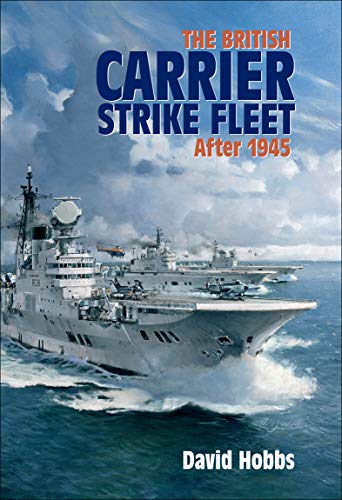Reviewed by Charles H. Bogart
Do not confuse this book with the author’s British Aircraft Carriers: Design, Development & Service Histories. This book concerns itself with the policy decisions that charted the Royal Navy’s carrier strike force decline from being the second largest in the world to non-existent. It is the story of a service that lost its way, of parochialism triumphing over the common good, and of political decisions made in isolation. This book builds on and supplements Eric Grove’s 1987 From Vanguard to Trident. The book is a comprehensive study of the post-World War II decline of the Royal Navy in favor of the deterrent power of the atomic bomb. The author occasionally takes to the pulpit to make his point that a nation’s reliance on the possession of atomic bombs to ensure peace is a fallacy of sizable magnitude.
The Royal Navy did not regain control of its air arm, after losing it in 1917 to the Royal Air Force (RAF), until 1937. This date was just two years before the start of World War II. The war would result in the Fleet Air Arm growing a hundred-fold. In 1945, a Royal Navy force of six fleet carriers equipped largely with American aircraft took the war to the Japanese homeland. From this epitome of power and strength, the Fleet Air Arm slowly went into decline for a number of reasons. These ranged from internal manning problems, carriers that were obsolete, a national air industry unable to produce naval aircraft at a reasonable cost, a government more interested in social welfare programs than modernizing its navy, and a non-coherent defense program. Yet, despite this, it was the Royal Navy that pioneered the angled deck, developed the mirror landing assistance device, put into operation the steam catapult, and conducted the first jet landing on a carrier.
Time after time it was Fleet Air Arm aircraft that had to step in and carry out an international mission the Royal Air Force (RAF) was unable to perform, yet the RAF generally won the budget battle by proclaiming that it now had the aircraft to perform cheaper than any mission’s carrier aircraft could. Even the fact that the RAF was unable to bring any weight against the invading Argentine force in the Falkland Island War of 1982 failed to register with the political establishment.
The chapter on the Royal Navy’s involvement in the Korean War is well worth a read. A total of five Royal Navy carriers operated in Korean waters. Then in 1956, five Royal Navy carriers participated in the Suez Canal Operation. Carriers also saw action during the period 1946 to 2000 by showing the flag or in providing direct support during various colonial crises and in support of United Nations sponsored peacekeeping and peacemaking operations. The author provides an excellent discussion platform that delves into the philosophy, planning, design, and execution of naval aviation policy within the Royal Navy and the British government. The story of the design philosophy in the development of the Commando Carrier is an interesting read of the concept of “Let’s explore all options.” The design story of the Royal Navy’s unbuilt CVA-01 reads like the U.S. Navy’s controversy over building more Nimitz class ships or a new “medium aircraft carrier.” The overall failure by the Royal Navy to replace its aging carriers, with the resulting order to stand down the Fleet Air Arm, is the story of bean counters triumphing over the full spectrum of operational needs of the British armed forces. Once the Royal Navy’s aircraft carrier fleet had been destroyed it soon became apparent to the British public that with the Royal Navy lacking an aircraft carrier, their nation now lacked the ability to respond to the various air, land, and maritime threats facing the United Kingdom. Thus, the resulting order for the Queen Elizabeth class of carriers.
The author makes no secret that he is a proponent of carrier-based air power. His arguments for his position are clear and concise. He rails within the pages of his book against what he sees as political ignorance and meddling, the failure by the Royal Navy to develop a coherent policy to guide itself during the decades after World War II, and the partisanship displayed by the RAF in constantly claiming that they could do more at a cheaper cost than they could actually carry out. Overall, the author’s postulations championing the Fleet Air Arm are well formulated.
To the reviewer, the main problem that internally divided the Royal Navy in the 1950s and 1960s was that it had fought two separate and distinct wars within the context of World War II. The Atlantic Ocean war was a story of trade protection, while the war in the Mediterranean Sea and the Pacific Ocean centered on fleet actions. Thus, the Royal Navy’s high command, as they tried to formulate the post war navy, lacked a common understanding of modern naval warfare.
I found this book to be a great read and highly recommend it to those who want to understand the decline of the Royal Navy since the end of World War II. It will be a disturbing read but it will also make you say, “What If?” What if there had been no 1949 “Revolt of the Admirals?” Would the story of the decline of Royal Navy aviation also have been the story of U.S. Naval aviation?
Charles H. Bogart is a frequent contributor to Naval History Book Reviews.
The British Carrier Strike Fleet After 1945 (David Hobbs, Seaforth Publications, Barnsley, South Yorkshire, Great Britain, 2015)


